四大组件之服务Service
什么是服务呢?
用俗话话应该是长期于后台运行的程序,如果是官方一点,首先它是一个组件,用于执行长期运行的任务,并且与用户没有交互。
每一个服务都需要在配置文件AndroidManifest.xml文件里进行生命,怎么生命呢?
使用标签,其实跟前面的activity,广播接收者receiver一样生命。
通过Context.startService()来开启服务,通过Context.stop()来停止服务。当然啦,还有一种启动形式就是通过Context.bindService()的方法。
为什么要使用服务呢?
从上面的文字说,我们知道这个服务是用于执行长期后台运行的操作。有些时候,我们没有界面,但是程序仍然需要工作。比如说,我们播放音乐,在后台播放音乐。比如说,我们下载任务,在后台下载文件。这些都是没有界面 的后台运行程序,这些都是用服务做的。
所以,服务就有它的用处了。
第二个原因是什么呢?先给大家讲几个概念:
1、前台进程:可以理解为是最顶部的,直接跟用户交互的。比如说我们操作的Activity界面.
2、可见进程:可以见的,但是不操作的,比如说我们在一个Activity的顶部弹出一个Dialog,这个Dialog就是前台进程,但是这个Activity则是可见进程。
3、服务进程:服务可以理解为是忙碌的后台进程,虽然是在后台,但是它很忙碌。
4、后台进程:后台进程就是退隐到后台,不做事的进程。
5、空进程:空进程是不做事的,没有任何东西在上面跑着,仅作缓存作用。
假设,内存不够用了,会先杀谁呢?
首先杀的是空进程,要是还不够就杀后台进程,要是还不够,那么就杀服务,但是服务被杀死以后,等内存够用了,服务又会跑起来了。
所以:如果我们需要长期后台操作的任务,使用Service就对了!其实Framework里多数是服务。如果我们进行音乐播放,即使退到了后台,也可以播放,我们使用服务完成吧!如果我们下载东西,退到后台也能下载,那么我们就使用服务吧!如果我们在不停地记录日志,那我们就用服务吧!
如果面试问到:服务用于执行耗时操作,这是对的吗?
如时服务直接执行耗时操作,也会出现anr.
在这里给大家补充一下anr的时长知识。首先ANR的意思是android no response,也就是无相应或者理解为操作超时。
在android系统中广播的ANR时长为:
// How long we allow a receiver to run before giving up on it.
static final int BROADCAST_FG_TIMEOUT = 10*1000;
static final int BROADCAST_BG_TIMEOUT = 60*1000;
前台广播为10秒,后台广播为60秒。
按键操作的anr时长为:
// How long we wait until we timeout on key dispatching.
static final int KEY_DISPATCHING_TIMEOUT = 5*1000;
按钮事件的时长为5秒,常指的是Activity的操作。
// How long we wait for a service to finish executing.
static final int SERVICE_TIMEOUT = 20*1000;
// How long we wait for a service to finish executing.
static final int SERVICE_BACKGROUND_TIMEOUT = SERVICE_TIMEOUT * 10;
服务的话,前台服务为20秒超时,后台服务为200秒超时。
以上。
如果在服务中直接做耗时操作,也是会出现ANR异常的。服务可以长期在后台运行,所以你可以这么做:如果要做耗时操作,比如说网络的访问,数据库的读写之类的,可以开线程去做。
服务的生命周期
前面我们知道了为什么要使用服务,接下来我们就使用一下服务,并且学习一下它的生命周期。
我们要写代码了:
首先,创建一个类,继承Service,就像我们之前写Activity要继承自Activity,而广播则继承自BroadcastReceiver。代码如下:
package com.sunofbeaches.servicedemo;
import android.app.Service;
import android.content.Intent;
import android.os.IBinder;
import android.support.annotation.Nullable;
import android.util.Log;
/**
* Created by TrillGates on 18/4/5.
* God bless my code!
*/
public class FirstService extends Service{
private static final String TAG = "FirstService";
@Nullable
@Override
public IBinder onBind(Intent intent) {
return null;
}
@Override
public void onCreate() {
Log.d(TAG, "onCreate...");
super.onCreate();
}
@Override
public int onStartCommand(Intent intent, int flags, int startId) {
Log.d(TAG, "onStartCommand...");
return super.onStartCommand(intent, flags, startId);
}
@Override
public void onDestroy() {
Log.d(TAG, "onDestroy...");
super.onDestroy();
}
}
接着,我们写一个Activity去控制服务:
package com.sunofbeaches.servicedemo;
import android.content.Intent;
import android.os.Bundle;
import android.support.v7.app.AppCompatActivity;
import android.util.Log;
import android.view.View;
public class MainActivity extends AppCompatActivity {
private static final String TAG = "MainActivity";;
@Override
protected void onCreate(Bundle savedInstanceState) {
super.onCreate(savedInstanceState);
setContentView(R.layout.activity_main);
}
public void startService(View view) {
Log.d(TAG, "start service ... ");
startService(new Intent(this, FirstService.class));
}
public void stopService(View view) {
Log.d(TAG, "stop service....");
stopService(new Intent(this, FirstService.class));
}
}
注册服务,四大组件都需要注册。在配置文件里配置如下:
<service android:name=".FirstService"></service>
以前我们在学习Activity的时候,就知道显示意图和隐式意图了。其实服务也是一样的,启动方式也有显式和隐式的。
上面的Activity中我们直接使用显式意图来启动服务。如果需要使用隐式意图的方式去启动,则需要配置一个意图过滤。
执行结果:

可以看出,我们在startService之后,就执行了onCreate方法,接着是onStartCommand方法。当我们执行stopService的时候,就会走onDestroy方法了。
这就是服务最基本的生命周期了。其实onStart也是服务的生命周期,只是这个方法已经过时了。
当然啦,服务的生命周期并没有这么简单,我们后面再详细去探讨吧!
绑定启动服务
前面的开启服务方式,有一个弊端。就是没法进行通讯。所以我们接直来呢会学习另外一种启动服务的方式–通过绑定服务的形式来启动服务。
绑定服务,对应的停止服务则是解绑服务了!
好,我们看代码吧:
这是我们的第二个服务:
package com.sunofbeaches.servicedemo;
import android.app.Service;
import android.content.Intent;
import android.os.IBinder;
import android.util.Log;
/**
* Created by TrillGates on 18/4/18.
* God bless my code!
*/
public class SecondService extends Service {
private static final String TAG = "SecondService";
@Override
public IBinder onBind(Intent intent) {
Log.d(TAG, "onBind");
return null;
}
@Override
public boolean onUnbind(Intent intent) {
Log.d(TAG, "onUnbind");
return super.onUnbind(intent);
}
@Override
public void onCreate() {
Log.d(TAG, "onCreate");
super.onCreate();
}
@Override
public int onStartCommand(Intent intent, int flags, int startId) {
Log.d(TAG, "onStartCommand");
return super.onStartCommand(intent, flags, startId);
}
@Override
public void onDestroy() {
Log.d(TAG, "onDestroy");
super.onDestroy();
}
}
然后,在清单文件里注册一下:
<service android:name=".SecondService"></service>
注册完以后,我们编写一个主界面,我们叫做:BindServiceActivity
package com.sunofbeaches.servicedemo;
import android.app.Activity;
import android.content.ComponentName;
import android.content.Intent;
import android.content.ServiceConnection;
import android.os.Bundle;
import android.os.IBinder;
import android.view.View;
/**
* Created by TrillGates on 18/4/18.
* God bless my code!
*/
public class BindServiceActivity extends Activity {
@Override
protected void onCreate(Bundle savedInstanceState) {
super.onCreate(savedInstanceState);
setContentView(R.layout.activity_bind_service);
}
public void bindServiceClick(View view) {
//创建意图对象
Intent intent = new Intent(this, SecondService.class);
//第一个是参数是意图对象,第二个参数是回调,第三个参数是标记,这个是自动创建的意,如果服务没有start,那么会自己创建。
//automatically create the service as long as the binding exists
bindService(intent, mServiceConnection, BIND_AUTO_CREATE);
}
private ServiceConnection mServiceConnection = new ServiceConnection() {
@Override
public void onServiceConnected(ComponentName name, IBinder service) {
}
@Override
public void onServiceDisconnected(ComponentName name) {
}
};
public void unBindServiceClick(View view) {
//解绑服务
if (mServiceConnection != null) {
unbindService(mServiceConnection);
}
}
}
界面是这样子的:
<?xml version="1.0" encoding="utf-8"?>
<LinearLayout
xmlns:android="https://schemas.android.com/apk/res/android"
android:layout_width="match_parent"
android:layout_height="match_parent"
android:orientation="vertical">
<Button
android:onClick="bindServiceClick"
android:layout_width="match_parent"
android:layout_height="wrap_content"
android:text="绑定服务"/>
<Button
android:onClick="unBindServiceClick"
android:layout_width="match_parent"
android:layout_height="wrap_content"
android:text="解绑服务"/>
</LinearLayout>
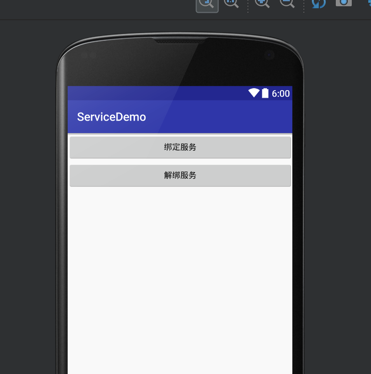
这两个按钮的功能就是绑定服务和解绑服务,可以看上面的代码,其实非常简单的!
我们第一个步骤就是先把服务绑定,启动起来。第二步我们才去研究怎么样进行通讯。
把这个程序跑起来,是怎么样子的呢?

好的,到这里,我们已经实现了通过绑定服务和启动服务来启动服务。并且通过解绑服务来停止服务。
接下来,我们看一下,Activity跟服务之间是怎么通讯的。我们可以看到服务的生命周期有点不一样了!它会执行onBind方法:
@Override
public IBinder onBind(Intent intent) {
Log.d(TAG, "onBind");
return null;
}
这个方法里头呢,我们需要返回一个东西,也就是IBinder,假设我们现在这样子,需要调用服务里的一个方法,我们可以在里面声明 一个方法叫服务的内部方法!
我们把服务写成这样子:
package com.sunofbeaches.servicedemo;
import android.app.Service;
import android.content.Intent;
import android.os.Binder;
import android.os.IBinder;
import android.util.Log;
/**
* Created by TrillGates on 18/4/18.
* God bless my code!
*/
public class SecondService extends Service {
public class CommunicateBinder extends Binder{
void callInnerMethod(){
innerMethod();
}
}
private static final String TAG = "SecondService";
private void innerMethod() {
Log.d(TAG, "innerMethod was called...");
}
@Override
public IBinder onBind(Intent intent) {
Log.d(TAG, "onBind");
return new CommunicateBinder();
}
@Override
public boolean onUnbind(Intent intent) {
Log.d(TAG, "onUnbind");
return super.onUnbind(intent);
}
@Override
public void onCreate() {
Log.d(TAG, "onCreate");
super.onCreate();
}
@Override
public int onStartCommand(Intent intent, int flags, int startId) {
Log.d(TAG, "onStartCommand");
return super.onStartCommand(intent, flags, startId);
}
@Override
public void onDestroy() {
Log.d(TAG, "onDestroy");
super.onDestroy();
}
}
有一个服务内部的类,继承了binder类,其实binder类的话是实现了IBinder接口的:
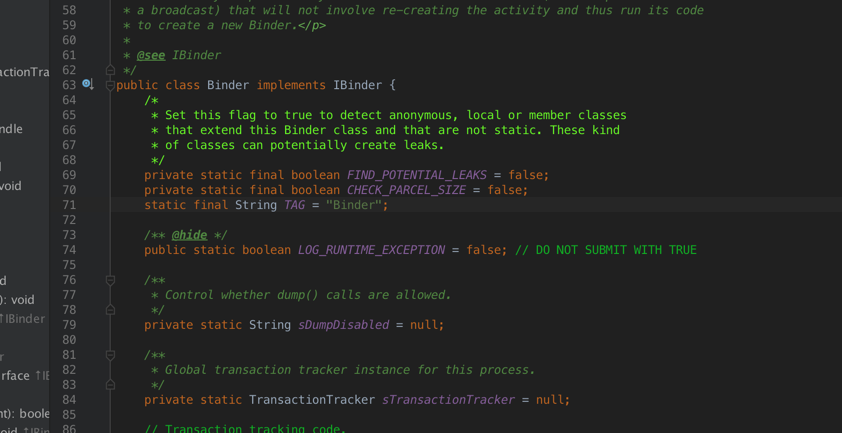
所以我们在绑上的时候,就返回这个类给绑定服务的地方,我们看看绑定服务的地方是怎么获取到这个类的:
package com.sunofbeaches.servicedemo;
import android.app.Activity;
import android.content.ComponentName;
import android.content.Intent;
import android.content.ServiceConnection;
import android.os.Bundle;
import android.os.IBinder;
import android.view.View;
/**
* Created by TrillGates on 18/4/18.
* God bless my code!
*/
public class BindServiceActivity extends Activity {
@Override
protected void onCreate(Bundle savedInstanceState) {
super.onCreate(savedInstanceState);
setContentView(R.layout.activity_bind_service);
}
public void bindServiceClick(View view) {
//创建意图对象
Intent intent = new Intent(this, SecondService.class);
//第一个是参数是意图对象,第二个参数是回调,第三个参数是标记,这个是自动创建的意,如果服务没有start,那么会自己创建。
//automatically create the service as long as the binding exists
bindService(intent, mServiceConnection, BIND_AUTO_CREATE);
}
private SecondService.CommunicateBinder mCommunicateBinder;
private ServiceConnection mServiceConnection = new ServiceConnection() {
@Override
public void onServiceConnected(ComponentName name, IBinder service) {
if (service instanceof SecondService.CommunicateBinder) {
mCommunicateBinder = (SecondService.CommunicateBinder) service;
}
}
@Override
public void onServiceDisconnected(ComponentName name) {
}
};
public void unBindServiceClick(View view) {
//解绑服务
if (mServiceConnection != null) {
unbindService(mServiceConnection);
}
}
public void callServiceMethod(View view) {
if (mCommunicateBinder != null) {
//调用服务内部的方法
mCommunicateBinder.callInnerMethod();
}
}
}
这里面有一段代码是:
@Override
public void onServiceConnected(ComponentName name, IBinder service) {
if (service instanceof SecondService.CommunicateBinder) {
mCommunicateBinder = (SecondService.CommunicateBinder) service;
}
}
我们就是这样子拿到了绑定上以后传回来的那个类,这样子我们就可以调用服务里的方法了:
public void callServiceMethod(View view) {
if (mCommunicateBinder != null) {
//调用服务内部的方法
mCommunicateBinder.callInnerMethod();
}
}
在UI上添加了一个按钮,看一下我们测试的结果:
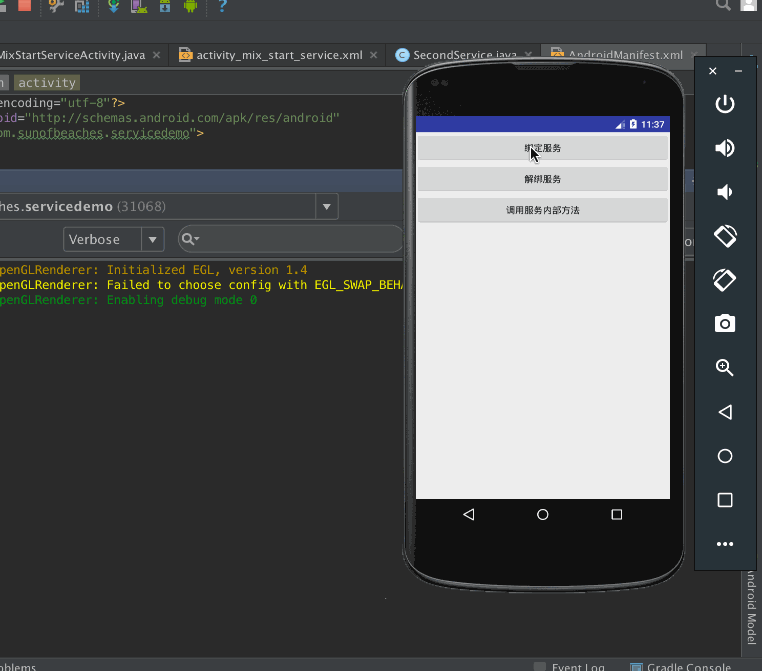
这样子我们就可以控制服务了,假设说我们有一个服务在后台跑着,用它来播放音乐的,因为我们音乐可以后台播放呀,对吧!这个时间 ,我们需要控制音乐的播放和暂停了,就可以通过这种形式去控制音乐了。
这样的代码还不够完美,对于服务内部的方法,应该隐藏起来,而公共的东西进行抽取,所以,我们应该定义一个接口,把服务里的:
public class CommunicateBinder extends Binder{
void callInnerMethod(){
innerMethod();
}
}
这个方法隐藏起来,那隐藏起来以后,外部怎么能调用呢?当然是通过接口的形式来实现啦!
我们创建一个接口:
package com.sunofbeaches.servicedemo.interfaces;
/**
* Created by TrillGates on 18/4/20.
* God bless my code!
*/
public interface IServiceControl {
void callServiceInnerMethod();
}
接着,我们私有服务里这个类,并且实现这个接口:
private class CommunicateBinder extends Binder implements IServiceControl{
@Override
public void callServiceInnerMethod() {
innerMethod();
}
}
这样子,我们在服务连接上以后,就可以强转成接口来调用了:
你看,已经没法调用了,因为这个类已经私有了!
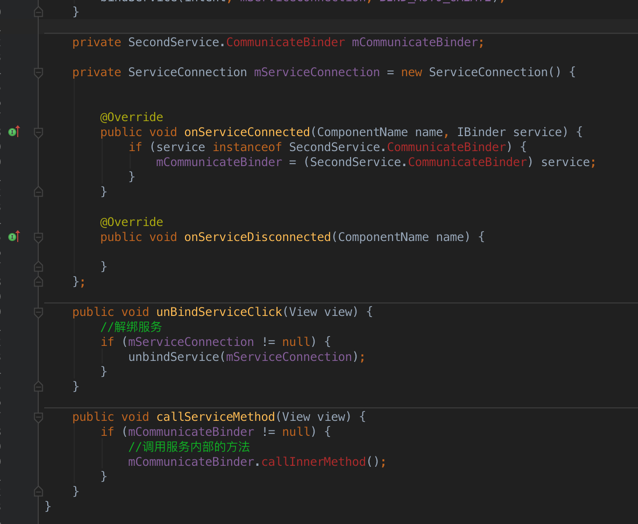
把代码改成这样子:
package com.sunofbeaches.servicedemo;
import android.app.Activity;
import android.content.ComponentName;
import android.content.Intent;
import android.content.ServiceConnection;
import android.os.Bundle;
import android.os.IBinder;
import android.view.View;
import com.sunofbeaches.servicedemo.interfaces.IServiceControl;
import com.sunofbeaches.servicedemo.services.SecondService;
/**
* Created by TrillGates on 18/4/18.
* God bless my code!
*/
public class BindServiceActivity extends Activity {
@Override
protected void onCreate(Bundle savedInstanceState) {
super.onCreate(savedInstanceState);
setContentView(R.layout.activity_bind_service);
}
public void bindServiceClick(View view) {
//创建意图对象
Intent intent = new Intent(this, SecondService.class);
//第一个是参数是意图对象,第二个参数是回调,第三个参数是标记,这个是自动创建的意,如果服务没有start,那么会自己创建。
//automatically create the service as long as the binding exists
bindService(intent, mServiceConnection, BIND_AUTO_CREATE);
}
private IServiceControl mCommunicateBinder;
private ServiceConnection mServiceConnection = new ServiceConnection() {
@Override
public void onServiceConnected(ComponentName name, IBinder service) {
if (service instanceof IServiceControl) {
mCommunicateBinder = (IServiceControl) service;
}
}
@Override
public void onServiceDisconnected(ComponentName name) {
}
};
public void unBindServiceClick(View view) {
//解绑服务
if (mServiceConnection != null) {
unbindService(mServiceConnection);
}
}
public void callServiceMethod(View view) {
if (mCommunicateBinder != null) {
//调用服务内部的方法
mCommunicateBinder.callServiceInnerMethod();
}
}
}
这样子的效果是一样的,但是代码非常优雅!估计能理解这个的同学就可以体会到了接口有多么有用了!
但是,以绑定的方式启动的服务,在context销毁的时候,必须解绑,否则会泄漏:

报错内容:
[ 04-19 23:02:28.741 1509: 1597 D/ ]
HostConnection::get() New Host Connection established 0xa034adf0, tid 1597
Activity com.sunofbeaches.servicedemo.BindServiceActivity has leaked ServiceConnection com.sunofbeaches.servicedemo.BindServiceActivity$1@13ae5f6b that was originally bound here
android.app.ServiceConnectionLeaked: Activity com.sunofbeaches.servicedemo.BindServiceActivity has leaked ServiceConnection com.sunofbeaches.servicedemo.BindServiceActivity$1@13ae5f6b that was originally bound here
at android.app.LoadedApk$ServiceDispatcher.<init>(LoadedApk.java:1077)
at android.app.LoadedApk.getServiceDispatcher(LoadedApk.java:971)
at android.app.ContextImpl.bindServiceCommon(ContextImpl.java:1774)
at android.app.ContextImpl.bindService(ContextImpl.java:1757)
at android.content.ContextWrapper.bindService(ContextWrapper.java:539)
at com.sunofbeaches.servicedemo.BindServiceActivity.bindServiceClick(BindServiceActivity.java:27)
at java.lang.reflect.Method.invoke(Native Method)
at java.lang.reflect.Method.invoke(Method.java:372)
at android.view.View$1.onClick(View.java:4015)
at android.view.View.performClick(View.java:4780)
at android.view.View$PerformClick.run(View.java:19866)
at android.os.Handler.handleCallback(Handler.java:739)
at android.os.Handler.dispatchMessage(Handler.java:95)
at android.os.Looper.loop(Looper.java:135)
at android.app.ActivityThread.main(ActivityThread.java:5254)
at java.lang.reflect.Method.invoke(Native Method)
at java.lang.reflect.Method.invoke(Method.java:372)
at com.android.internal.os.ZygoteInit$MethodAndArgsCaller.run(ZygoteInit.java:903)
at com.android.internal.os.ZygoteInit.main(ZygoteInit.java:698)
onUnbind
onDestroy
all threads took: 5.485ms
BindServiceActivity has leaked 这里已经说了泄漏了!
bindService开启的服务,在系统里是看不到服务在运行的:
如果是通过startService的方式启动的服务,则会在应用里看到:
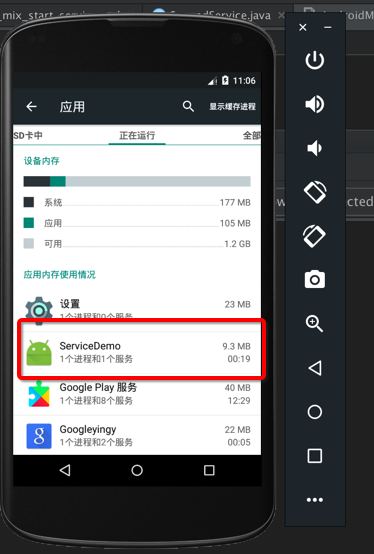
如果是通过bindService的方式来启动,则不会有
总结一下绑定服务的特点(这些内容会在视频里给大家做实验证明):
1、绑定服务在系统设置里是没有显进服务正在跑着的;
2、如果onBind方法返回的是null,那么onServiceConnected方法不会被调用;
3、绑定服务的生命周期跟Activity是不求同时生,但求同时死,Activity没了,服务也要解绑;
4、服务在解除绑定以后会停止运行,执行unBind方法—>onDestroy方法;
5、绑定服务开启的服务,只可以解绑一次,多次解绑会抛异常;
6、绑定的connection要跟解绑的connection要对应着,否则没法解绑。
稍微总结一下,startService和bindService的区别,优点和缺点:
1、startService这个方法来启动服务的话,是长期运行的,只有stopService才会停止服务。而bindService来启动服务,不用的时候,需要调用unBindService,否则会导致context泄漏,所以bindService不是长期运行的。当context销毁的时候,则会停止服务运行。
2、startService来启动服务可以长期运行,但是不可以通讯,而bindService的方式来启动服务则可以通讯,两者都有优缺点,所以我们就有了混合起来使用的方法。
接下来,我们会学习服务的混合开启方式,达到互补的效果。
混合启动服务
在前面的基础上,我们把开启服务,停止服务,绑定服务,解绑服务,调用服务内部的方法结合起来。再看看它的生命周期,以及作用效果。
首先,我们先总结一下服务的生命周期:
》startService–>stopService
这个生命周期我们前面已经看到了:
onCreate—>onStartCommand—->onDestroy
》bindService–>unBindService
这个生命周期,我们也从前面的例子中看到了:
onCreate—->onBind—>onUnbind—->onDestroy
在这一小节之前,我们提到,两种开启服务各有各自的优点和缺点。startService的方法可以长期地在后台运行,而bindService的方法则不可以长期于后台运行;bindService启动服务,可以跟服务进行通讯,但是startService启动服务不可以跟服务进行通讯。
我们混合两种开启方式,比如说,我们先startService,再进行bindService,这样子的话,服务可以长期于后台运行,又可以跟服务进行通讯了。
我们还是以例子的形式来学习一下:
我们在前面的例子稍加修改,添加了开启服务和停止服务,绑定服务和解绑服务不变,其实就是前面例子的结合体来的。
这个是界面:
<?xml version="1.0" encoding="utf-8"?>
<LinearLayout
xmlns:android="https://schemas.android.com/apk/res/android"
android:layout_width="match_parent"
android:layout_height="match_parent"
android:orientation="vertical">
<Button
android:layout_width="match_parent"
android:layout_height="wrap_content"
android:onClick="startServiceClick"
android:text="开启服务"/>
<Button
android:layout_width="match_parent"
android:layout_height="wrap_content"
android:onClick="stopServiceClick"
android:text="停止服务"/>
<Button
android:layout_width="match_parent"
android:layout_height="wrap_content"
android:onClick="bindServiceClick"
android:text="绑定服务"/>
<Button
android:layout_width="match_parent"
android:layout_height="wrap_content"
android:onClick="unBindServiceClick"
android:text="解绑服务"/>
<Button
android:layout_width="match_parent"
android:layout_height="wrap_content"
android:onClick="callServiceMethod"
android:text="调用服务内部方法"/>
</LinearLayout>
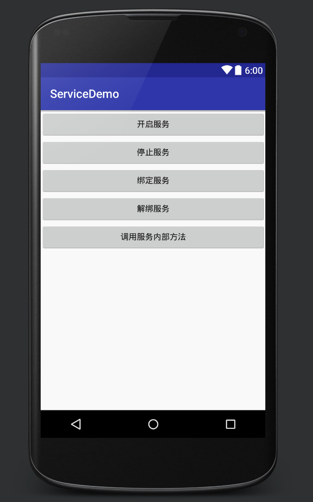
对应的,有点击事件,我们在activity里的代码实现一下:
package com.sunofbeaches.servicedemo;
import android.app.Activity;
import android.content.ComponentName;
import android.content.Intent;
import android.content.ServiceConnection;
import android.os.Bundle;
import android.os.IBinder;
import android.view.View;
import com.sunofbeaches.servicedemo.interfaces.IServiceControl;
import com.sunofbeaches.servicedemo.services.SecondService;
/**
* Created by TrillGates on 18/4/18.
* God bless my code!
*/
public class BindServiceActivity extends Activity {
@Override
protected void onCreate(Bundle savedInstanceState) {
super.onCreate(savedInstanceState);
setContentView(R.layout.activity_bind_service);
}
public void bindServiceClick(View view) {
//创建意图对象
Intent intent = new Intent(this, SecondService.class);
//第一个是参数是意图对象,第二个参数是回调,第三个参数是标记,这个是自动创建的意,如果服务没有start,那么会自己创建。
//automatically create the service as long as the binding exists
bindService(intent, mServiceConnection, BIND_AUTO_CREATE);
}
public void startServiceClick(View view) {
Intent intent = new Intent(this, SecondService.class);
startService(intent);
}
public void stopServiceClick(View view) {
Intent intent = new Intent(this, SecondService.class);
stopService(intent);
}
private IServiceControl mCommunicateBinder;
private ServiceConnection mServiceConnection = new ServiceConnection() {
@Override
public void onServiceConnected(ComponentName name, IBinder service) {
if (service instanceof IServiceControl) {
mCommunicateBinder = (IServiceControl) service;
}
}
@Override
public void onServiceDisconnected(ComponentName name) {
}
};
public void unBindServiceClick(View view) {
//解绑服务
if (mServiceConnection != null) {
unbindService(mServiceConnection);
}
}
public void callServiceMethod(View view) {
if (mCommunicateBinder != null) {
//调用服务内部的方法
mCommunicateBinder.callServiceInnerMethod();
}
}
}
然后我们就是开始使用啦!
第一个实验
》开启服务—>绑定服务—->调用服务的方法——>解绑服务——>停止服务(不停止服务它会一直跑着)
开启服务:
D/SecondService: onCreate D/SecondService: onStartCommand
绑定服务:
D/SecondService: onBind
调用服务的方法:
D/SecondService: innerMethod was called…
解绑服务:
D/SecondService: onUnbind
停止服务:
D/SecondService: onDestroy
从上面的操作记录来看,我们在解绑服务的时候,它并没有执行onDestroy方法,也就是说,服务还是在运行的。所以我们使用到了startService的好处:1、服务在后台长期运行;
而我们也是能调用服务内部的方法的,所以我们使用到了bindService的好处:2、跟服务进行通讯
也就是说,只要startService的方式开启服务,没有stopService,服务一直在运行者。
第二个实验:
我们去开启服务(startService)—->绑定服务(bindService)—–>停止服务(stopService)

从上面的图中,我们可以得出结论:通过startService,再去bindService,如果没有解绑,那么是停止不了服务的
实际开发中的模板流程:
第一步:startService–>这一步是为了服务可以长期后台运行 第二步:bindService–>这一步的目录是为了拿到服务的控制binder 第三步:调用服务里的方法 第四步:unBindService—>解绑服务,否则无法停止服务的(但是服务,仍然在后台运行) 第五步:在不需要服务的时候停止服务stopService
跨进程通讯AIDL
什么是AIDL呢?可能一般的开发人员使用的场景不多,但是就我现在做开发,天天用到,因为我做的launcher要显示所有第三方应用的附加界面,并且要进行通讯,所以就要用到AIDL了!
AIDL其实是:android interface definition language 安卓接口定义语言(其实这个使用得少,但是面试的时候会问一下吧!)
在例子开始之前,我们要了解一个概念:
IPC:inter process communication 进程间通讯。要知道什么是进程间通讯,那就要从进程的角度去理解了。在window下的话,我们打开一个应用,它就会给这个应用开一个进程。而在android里也是一样的,你看就知道了,在我们的ddms里头就有这么多的进程:
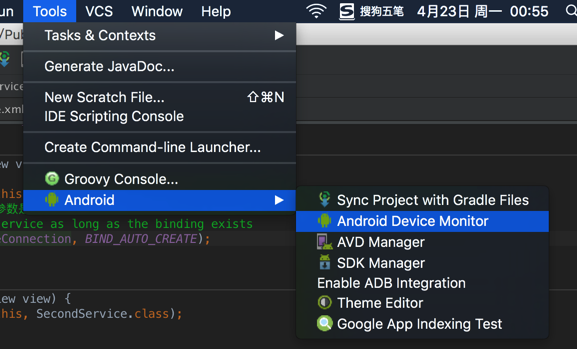
我们可以看到这些进程:
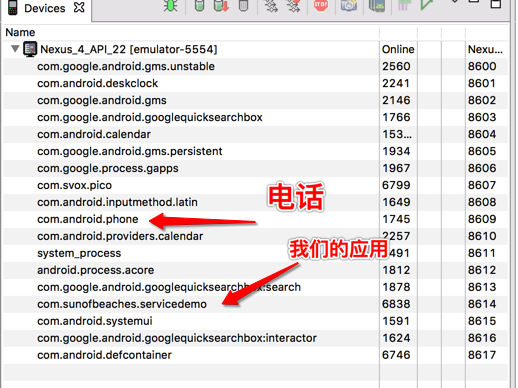
进程之间是独立的,而每个应用使用的内存也是独立的。为什么要独立呢,如果不独立的话就会存在安全问题呀!比如说,在你的应用里有支付相关的内容,如果其他应用可以访问得到的话,那么就危险了!对吧!
进程之间是独立的,那就有一个问题了!它们是怎么进行通讯的呢?有这样的场景呀,比如说:我们第三方应用要发起充值的业务,通过支付宝进行充值,调用支付宝简单,但是支付宝怎么把支付结果告诉我们的应用呢?对吧!
进程间的通讯,基本上在每个操作系统上都有这个概念。其实我们猜也能猜到是怎么实现的!
我们可以划出一个公共的内存空间,把要通讯的数据,通过这个空间来交流即可!而这个空间呢,就是binder了!
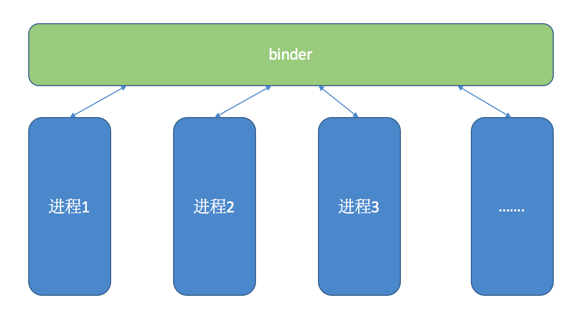
接下来的话,我们就会写一个例子,怎么样来跨进程通讯!
这个例子大概是这样子的:一个应用程序去调用另外一个应用里的服务里的方法。
如上所说,我们就是要创建两个应用了!
但是要先理解两个概念,本地服务和远程服务。
本地服务是相对于自己来说的,在自己应用上的服务,其实就是本地服务。相对于自己来说,服务在别人的应用上,那么就是远程服务了。
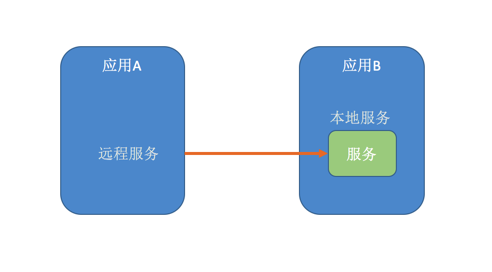
图中的服务相对于A来是远程服务相对于B来说是本地服务。
接下来的这个例子,我们就是有两个应用,一个是应用A,一个是应用B。在应用B里头有一个服务。然后呢,我们的应用A绑定应用B的服务,并且调用里面的方法。
第一步,创建两个应用:AIDLDemoA,和AIDLDemoB
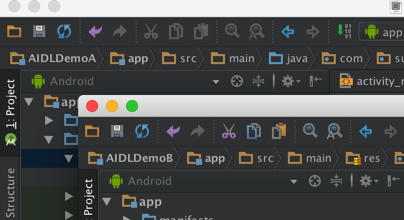
第二步:在 AIDLDemoB的程序里面创建一个服务:AppBService
package com.sunofbeaches.aidldemob;
import android.app.Service;
import android.content.Intent;
import android.os.IBinder;
/**
* Created by TrillGates on 18/4/23.
* God bless my code!
*/
public class AppBService extends Service {
@Override
public IBinder onBind(Intent intent) {
return null;
}
}
第三步,在配置文件里注册这个服务:
<service android:name=".AppBService"
android:exported="true">
<intent-filter>
<action android:name="com.sunofbeaches.aidldemob.INNER_SERVICE"/>
</intent-filter>
</service>
这里这个exported=”true”其实就是允许外部启动这个服务,绑定这个服务。默认就是true的,如果改成false了,外部就没法绑定/启动了。
这个action是给第三方应用(应用A)绑定用的。
第四步,重点来了:我们要创建AIDL接口:
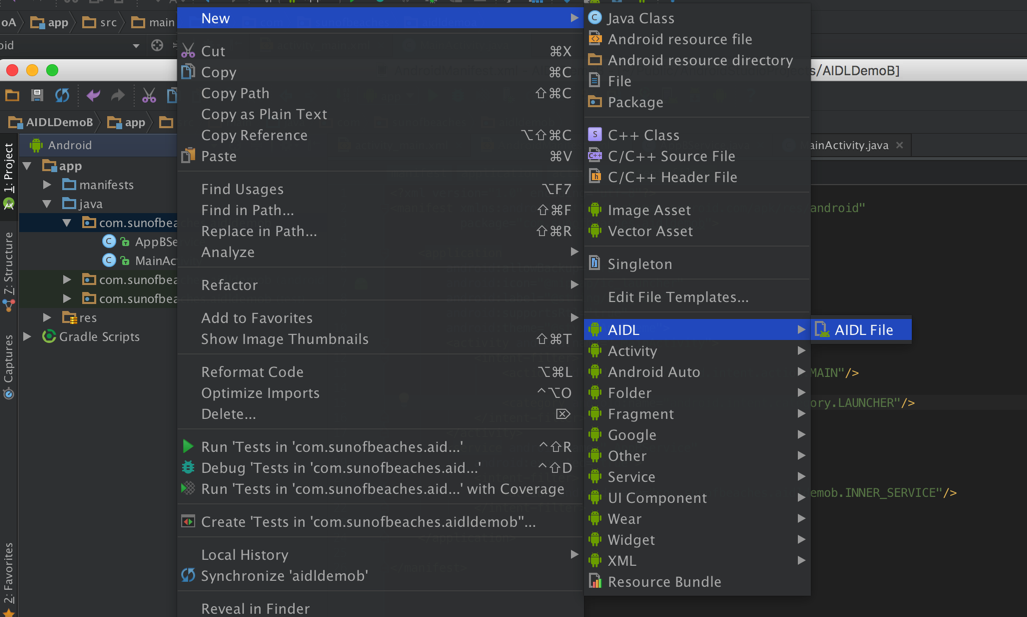
// IDemoBServiceControl.aidl
package com.sunofbeaches.aidldemob;
// Declare any non-default types here with import statements
interface IDemoBServiceControl {
/**
* Demonstrates some basic types that you can use as parameters
* and return values in AIDL.
*/
void basicTypes(int anInt, long aLong, boolean aBoolean, float aFloat,
double aDouble, String aString);
}
然后,就会创建这样一个文件了,对于AIDL的知识点挺多的,大家先学会怎么使用,后面再学习更多的内容,比如说,你要知道怎么要传一个自定义的bean类,怎么要相互控制,都是可以的。
这里面的话,我们就使用A应用,调用B应用里的服务的方法,并且把内容传过去。
// IDemoBServiceControl.aidl
package com.sunofbeaches.aidldemob;
interface IDemoBServiceControl {
void callInnerService();
void innserServicePrint(in String printContent);
}
基本数据类型不需要导包,我们自己定义的才要导包,这个以后我们会学到的。
第五步,我们点击build里的make一下,这样子就会自动生成一个类,所以我们才可以new出来:
package com.sunofbeaches.aidldemob;
import android.app.Service;
import android.content.Intent;
import android.os.IBinder;
import android.os.RemoteException;
import android.util.Log;
/**
* Created by TrillGates on 18/4/23.
* God bless my code!
*/
public class AppBService extends Service {
private static final String TAG = "AppBService";
@Override
public IBinder onBind(Intent intent) {
Log.d(TAG, "应用B的服务被绑定...");
return new IDemoBServiceControl.Stub() {
@Override
public void callInnerService() throws RemoteException {
innerMethod();
}
@Override
public void innerServicePrint(String printContent) throws RemoteException {
printMethod(printContent);
}
};
}
@Override
public boolean onUnbind(Intent intent) {
Log.d(TAG, "应用B的服务解绑了...");
return super.onUnbind(intent);
}
private void innerMethod() {
Log.d(TAG, "应用B的服务内部方法被调用了!...");
}
private void printMethod(String content) {
Log.d(TAG, "应用B的输出方法被调用,传过来的内容是 -- > " + content);
}
}
以上是我们服务修改成这样子,IDemoBServiceControl.Stub()这个类是根据我们的aidl接口生成的,它继承自己IBinder,所以我们可以直接new出来返回,当onBind的时候。
第五步:复制aidl的整个文件夹到应用A,视图如下:
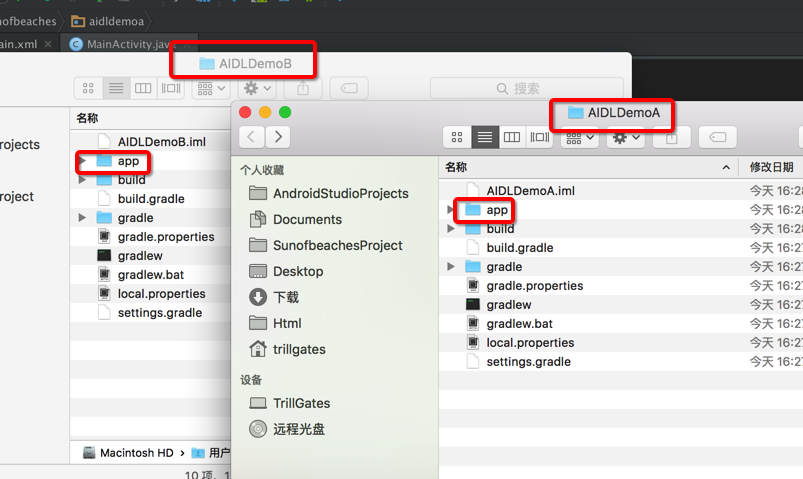
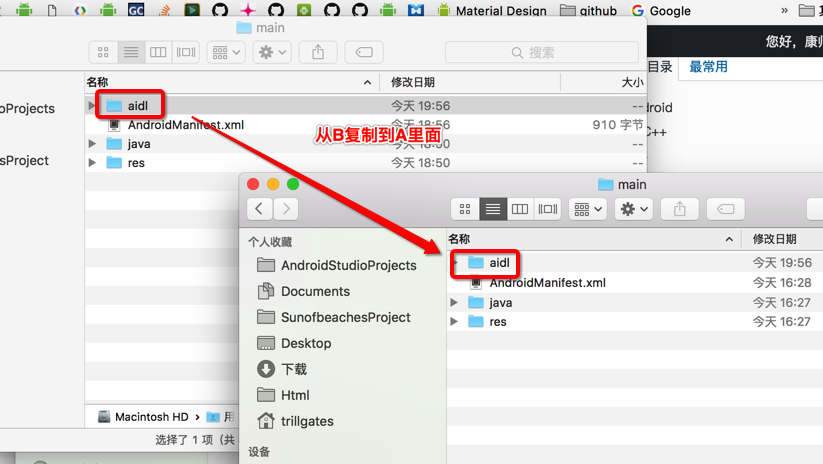
要注意的地方是:确保它们的包名是一样的。如图:
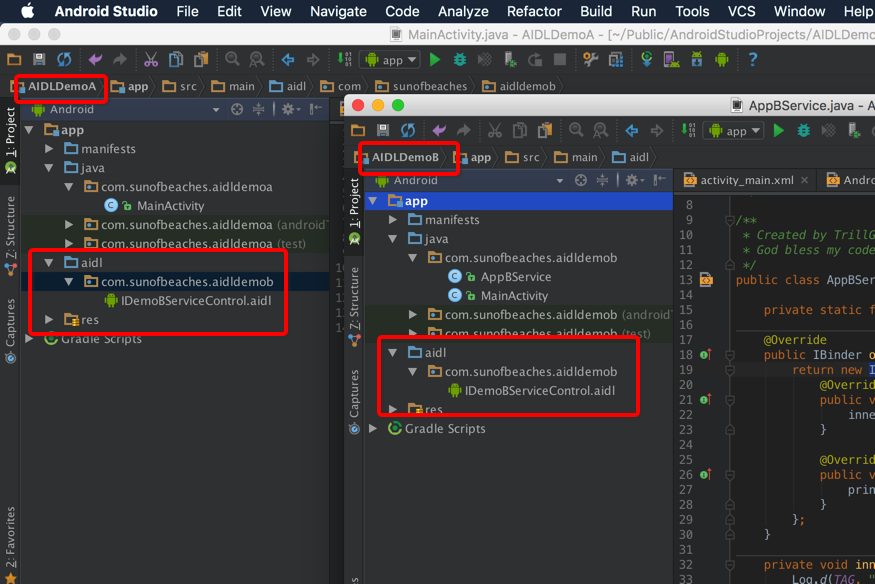
至于AIDL的原理,现在解释可能大家还没法理解。大家先按步骤去做,如果到这里已经很吃力了,那就去看视频好了。
然后,我们在应用A绑定服务的时候,就可以拿到这个接口的实现了,请看吧:
这是应用A的界面代码:
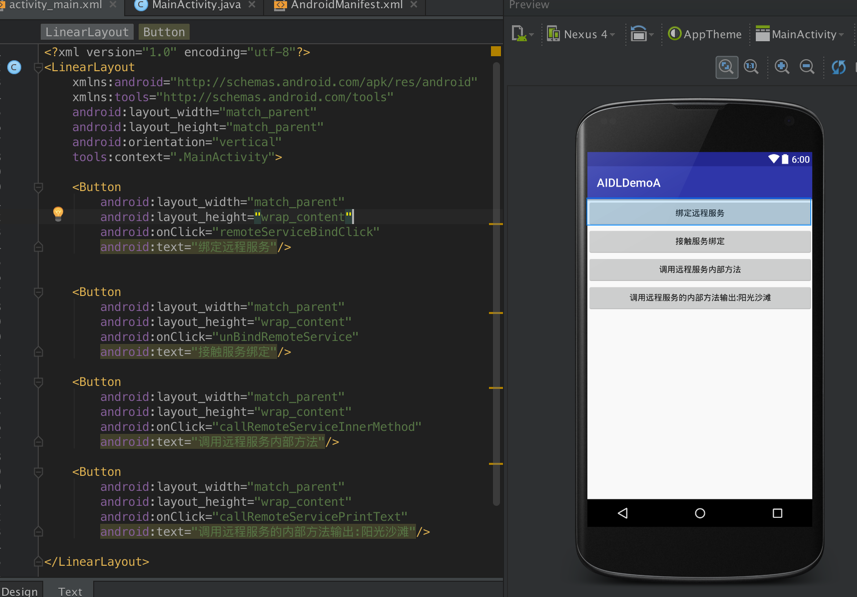
然后是主的Activity:
package com.sunofbeaches.aidldemoa;
import android.content.ComponentName;
import android.content.Intent;
import android.content.ServiceConnection;
import android.os.Bundle;
import android.os.IBinder;
import android.os.RemoteException;
import android.support.v7.app.AppCompatActivity;
import android.util.Log;
import android.view.View;
import com.sunofbeaches.aidldemob.IDemoBServiceControl;
public class MainActivity extends AppCompatActivity {
private static final String TAG = "MainActivity";
private IDemoBServiceControl mIDemoBServiceControl = null;
@Override
protected void onCreate(Bundle savedInstanceState) {
super.onCreate(savedInstanceState);
setContentView(R.layout.activity_main);
}
/**
* 这个方法用于绑定服务
*
* @param view
*/
public void remoteServiceBindClick(View view) {
Intent intent = new Intent();
//设置远程服务B的包名
intent.setPackage("com.sunofbeaches.aidldemob");
//设置服务的action: com.sunofbeaches.aidldemob.INNER_SERVICE
intent.setAction("com.sunofbeaches.aidldemob.INNER_SERVICE");
//绑定服务,服务不能重复绑定
if (mIDemoBServiceControl == null) {
bindService(intent, mServiceConnection, BIND_AUTO_CREATE);
}
}
private ServiceConnection mServiceConnection = new ServiceConnection() {
@Override
public void onServiceConnected(ComponentName name, IBinder service) {
//我们可以通过AIDL自动创建的类的一个方法,自动转,不需要强转了
mIDemoBServiceControl = IDemoBServiceControl.Stub.asInterface(service);
Log.d(TAG, "远程服务绑定了...");
}
@Override
public void onServiceDisconnected(ComponentName name) {
mIDemoBServiceControl = null;
Log.d(TAG, "远程服务断开绑定了...");
}
};
/**
* 这个方法用于解绑服务
*
* @param view
*/
public void unBindRemoteService(View view) {
unBindRemoteService();
}
/**
* 这个方法用于调用远程服务里的方法
*
* @param view
*/
public void callRemoteServiceInnerMethod(View view) {
if (mIDemoBServiceControl != null) {
try {
mIDemoBServiceControl.callInnerService();
} catch (RemoteException e) {
e.printStackTrace();
}
}
}
/**
* 这个方法用于调用远程服务的方法,让期输出内容
*
* @param view
*/
public void callRemoteServicePrintText(View view) {
if (mIDemoBServiceControl != null) {
try {
mIDemoBServiceControl.innerServicePrint("阳光沙滩");
} catch (RemoteException e) {
e.printStackTrace();
}
}
}
@Override
protected void onDestroy() {
super.onDestroy();
unBindRemoteService();
}
private void unBindRemoteService() {
if (mServiceConnection != null && mIDemoBServiceControl != null) {
unbindService(mServiceConnection);
mIDemoBServiceControl = null;
}
}
}
注释已经写清楚了,可以看注释,如果有问题的话,可以到社区网站里提问交流。
然后我们先跑起应用B,再跑起应用A。然后看应用B的Log,因为我们要看应用B的输出内容:

从上面的结果,我们可以看到,我们应用A控制应用B了,已经做到了跨应用(进程)进行通讯了,后面的话我们以一个实际的使用例子来说一下吧!
AIDL使用例子
例子请下载视频看吧
更牛逼的例子 更牛逼的例子,哈哈!我怕大家理解不了,因为涉及到了技术点比较多,工作中的一外例子,已经申请了专利。
在线视频教程
https://www.sunofbeach.net/c/1184309251795877888
四大组件之服务Service的更多相关文章
- Android四大组件之服务-Service 原理和应用开发详解
一.Android 服务简介 Service是android 系统中的四大组件之一(Activity.Service.BroadcastReceiver.ContentProvider),它跟Acti ...
- Android 四大组件之二(Service)
service可以在和多场合的应用中使用,比如播放多媒体的时候用户启动了其他Activity这个时候程序要在后台继续播放,比如检测SD卡上文件的变化,再或者在后台记录你地理信息位置的改变等等,总之服务 ...
- Android学习之基础知识十三 — 四大组件之服务详解第一讲
一.服务是什么 服务(Service)是Android中实现程序后台运行的解决方案,它非常适合去执行那些不需要和用户交互而且还要求长期运行的任务.服务的运行不依赖于任何用户界面,即使程序被切换到后台, ...
- [Android四大组件之二]——Service
Service是Android中四大组件之一,在Android开发中起到非常重要的作用,它运行在后台,不与用户进行交互. 1.Service的继承关系: java.lang.Object → andr ...
- Android四大组件之服务
创建一个服务,并与活动绑定 作为安卓四大组件之一的服务,毫无例外也要在manifast中进行注册 新建服务类继承于Service,并覆盖onBind( )方法,用于与活动绑定 public class ...
- Android四大组件初识之Service
Service作为Android四大组件之一,可以与Activity建立双向连接(绑定模式),提供数据和功能.也能够接收Intent单方面请求(调用模式),进行数据处理和调度功能. Service与A ...
- Android四大组件之服务的两种启动方式详解
Service简单概述 Service(服务):是一个没有用户界面.可以在后台长期运行且可以执行操作的应用组件.服务可由其他应用组件启动(如:Activity.另一个service).此外,组件可以绑 ...
- Android 编程下的四大组件之服务(Service)
服务(Service) 是一种在后台运行,没有界面的组件,由其他组件调用开始.Android 中的服务和 Windows 中的服务是类似的东西,它运行于系统中不容易被用户发觉,可以使用它开发如监控之类 ...
- Android四大组件之一:Service(服务)
Service跟Activity也是出于统一级别的组件,且与Activity的最大区别之一主要是没有人机界面,主要是运行在程序的后台(我是这么理解的),帮助文档上说的是运行于进程的主线程中,但是服务并 ...
- Android 四大组件(Activity、Service、BroadCastReceiver、ContentProvider)
转载于:http://blog.csdn.net/byxdaz/article/details/9708491 http://blog.csdn.net/q876266464/article/deta ...
随机推荐
- Redis-01 常用命令
创建和获取 key 命令 说明 例子 set 创建一个名为 key 值为 value 键值对 set views 10 get 获取名为 key 的值,存在返回值,不存在返回 nil get view ...
- Java读取文件后文件被占用
Java读取文件响应后文件一直被占用问题 原因: 由于是封装的函数,请求和响应对象都是 形参地址 虽然在此函数里关闭了输出流,但是由于有返回值,调用未结束,输出流无法提前关闭 解决: 1:调用函数后, ...
- HHKB Programming Contest 2022 Winter(AtCoder Beginner Contest 282)
前言 好久没有打 AtCoder 了.有点手生.只拿到了 \(\operatorname{rk}1510\),应该上不了多少分. 只切了 \(\texttt{A,B,C,D}\) 四题. A - Ge ...
- jQuery查找标签、操作标签、事件和动画效果,Bootstrap页面框架的介绍和使用讲解
今日内容 jQuery查找标签 1.基本选择器: $('#d1') id选择器 $('.c1') class选择器 $('div') 标签选择器 2.组合选择器: $('div#d1') 查找id是d ...
- 如何在现有的Vue项目中嵌入 Blazor项目?
目前官方只提供了angular和react俩种示例,所以本教程将来讲解如何在Vue的现有项目中使用,上期已经做好了react的教材! 准备流程 Vue 项目创建流程 使用Vue创建一个Demo项目 全 ...
- WPF-3D图形
WPF-3D图形 WPF的3D功能可以在不编写任何c#代码的情况下进行绘制,只需要使用xaml即可完成3D图形的渲染.本文主要讲述了WPF-3D中的关键概念, 以及常用到的命中测试.2d控件如何在3D ...
- vue中使用echarts来绘制中国地图,NuxtJS制作疫情地图,内有详细注释,我就懒得解释了,vue cli制作疫情地图 代码略有不同哦~~~
我的代码自我感觉----注释一向十分详细,就不用过多解释都是什么了~~ 因为最近疫情期间在家实在是没事干,想找点事,就练手了个小demo 首先上 NuxtJs版本代码,这里面 export defau ...
- SSM使用PageHelper
第一步---->导入Maven依赖 <!--pageHelper--> <dependency> <groupId>com.github.pagehelper ...
- ArrayList使用步骤-常用方法和遍历
ArrayList使用步骤 查看类 java.util.ArrayList :该类需要 import导入使后使用. 表示一种指定的数据类型,叫做泛型. E ,取自Element(元素)的首字母.在出现 ...
- drf-三大认证源码分析、基于APIView编写分页、异常处理
1.权限源码分析 1.APIView源码497行:self.initial(request, *args, **kwargs)中进行了三大认证. 2.在initial的源码中,以下三行代码是进行三大认 ...
